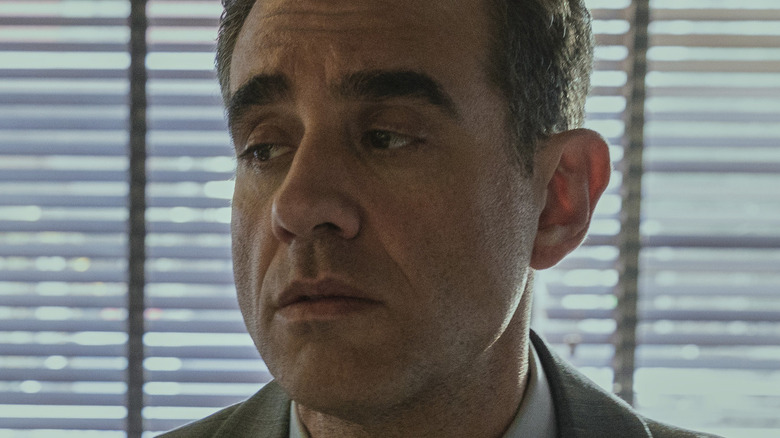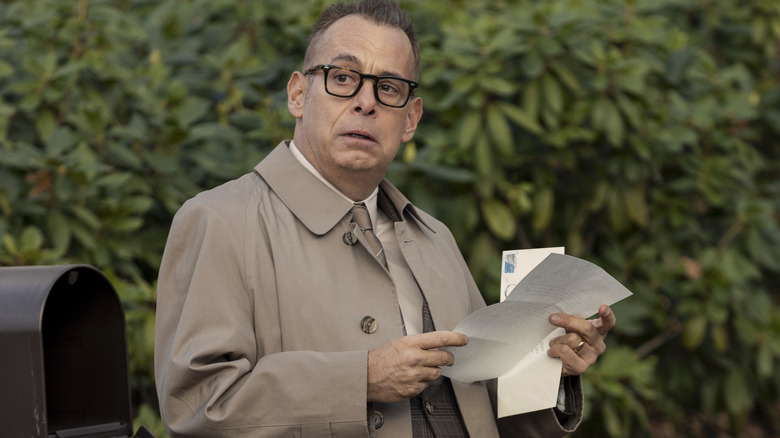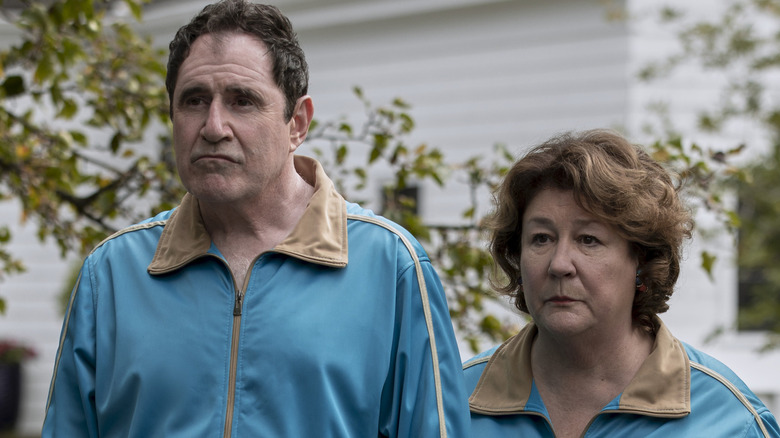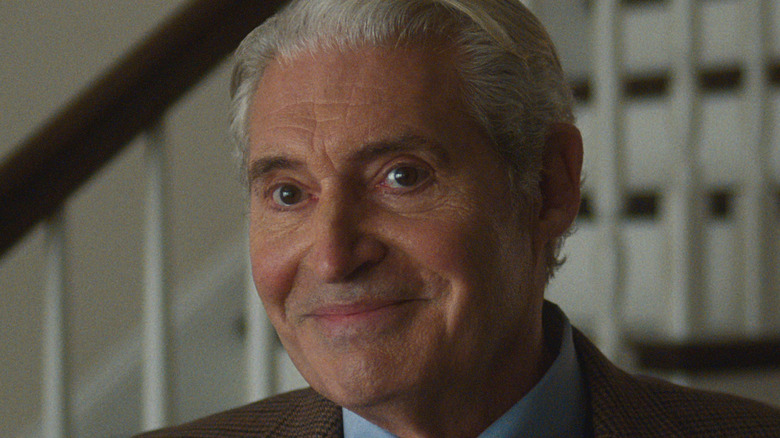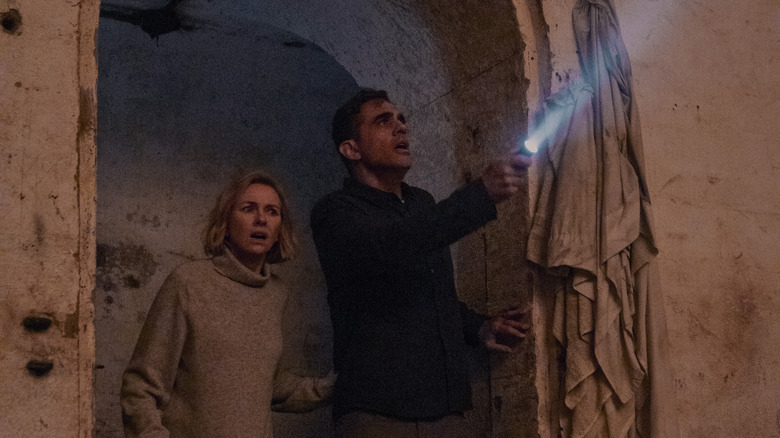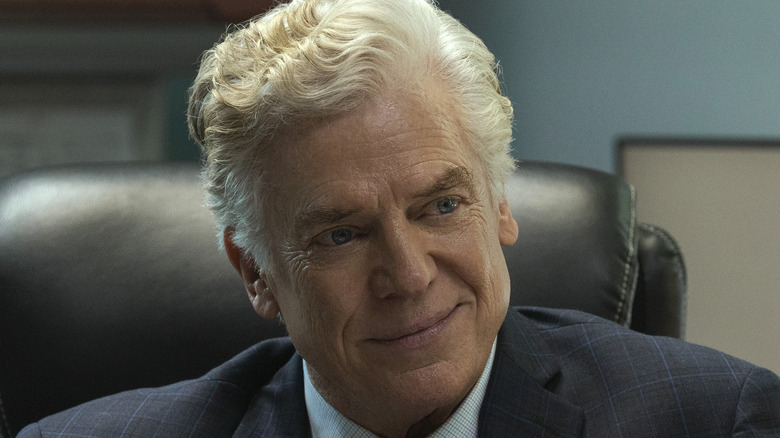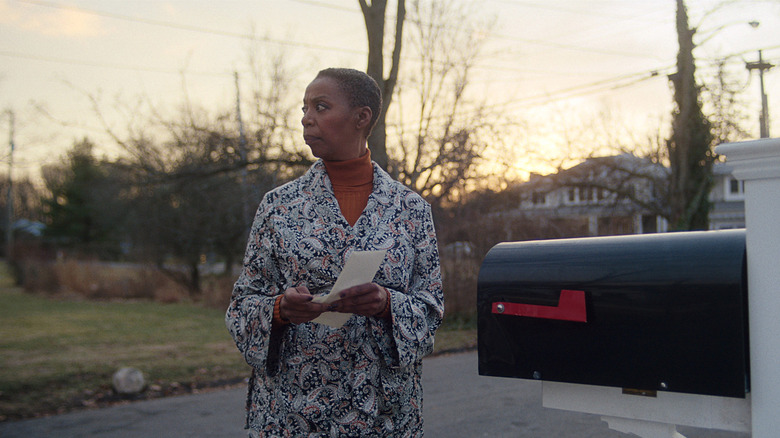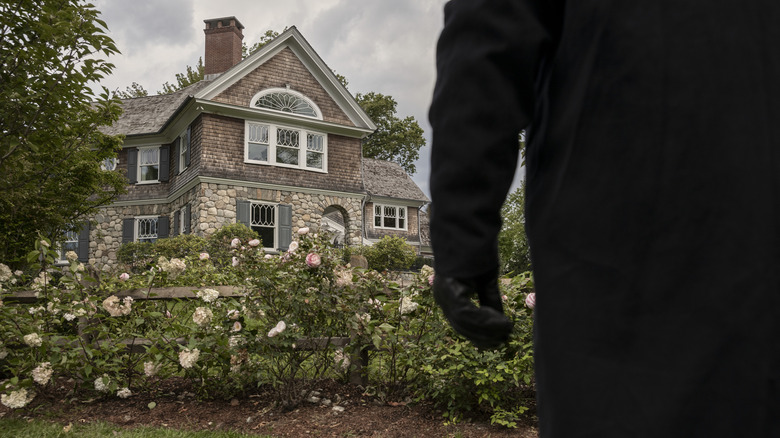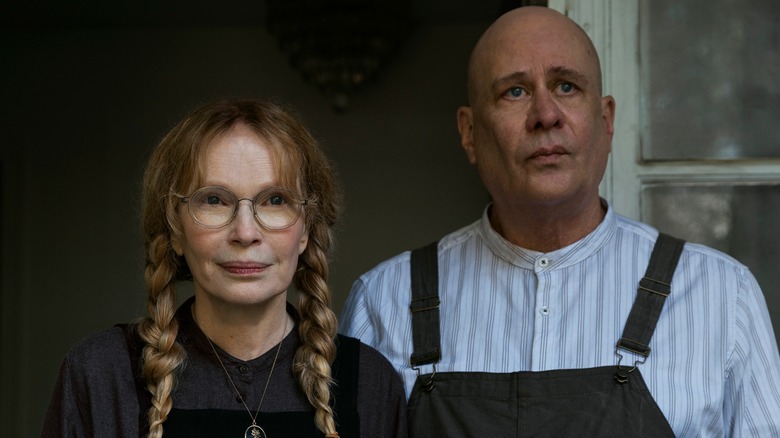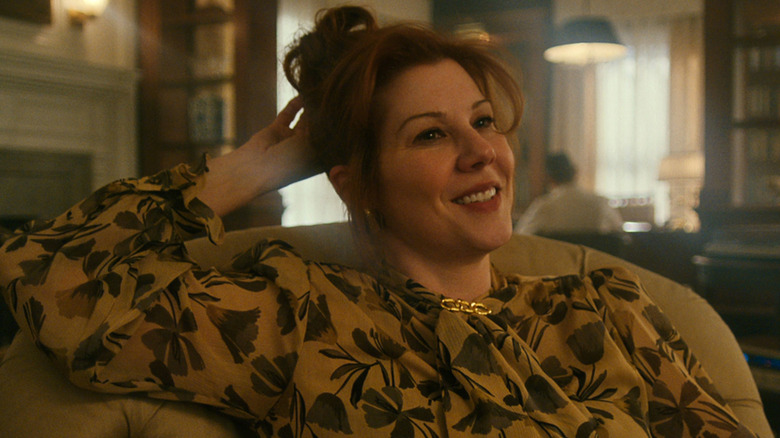Biggest Unanswered Questions From The Watcher Season 1
If you're one of the many people enjoying the modern true crime renaissance — and if supply is an accurate measure of demand, then you probably are — you're likely familiar with television kingpin Ryan Murphy and "The Watcher," one of his multiple projects for Netflix released in 2022. For over a decade, Murphy has been a dominant force in the world of spooky storytelling, conjuring up such smash hits as "American Horror Story" and "Dahmer — Monster: The Jeffrey Dahmer Story." "The Watcher" is ready to dole out even more mystery, mayhem, and murder. Of all the series' strengths, however, it's the mystery component that makes it worth watching for fans of Murphy, the real-life case of 657 Boulevard Avenue, or true crime in general.
At the end of the series' seventh and final episode, "The Watcher" leaves viewers with more questions than answers — if any of its myriad twists and reveals can be considered answers at all. The Brannock family never learns the true identity of the sinister figure known as the Watcher, nor why any of the stalking and suffering that they were subjected to even happened. They're left licking their wounds and scratching their heads, and so are we. Though we can't help them, we can help ourselves as we delve into the biggest unanswered questions from "The Watcher" Season 1.
Spoilers for "The Watcher" lie ahead.
Who was the pigtail girl?
Around the midpoint of "The Watcher" Season 1, the marriage of Nora Brannock (Naomi Watts) and Dean Brannock (Bobby Cannavale) is tested when a video leaks that seems to show Dean in his marriage bed about to have sex with an uncomfortably young-looking girl. She sports a nightgown and pigtails, looking in the grainy surveillance camera footage like an archetypal underage girl cliché — and that is no accident. According to Dean, the security system installer, and every clue the series grants us viewers, Dean has never seen that girl before in his life. Even during the night in question, he apparently sleeps through the entire incident, never has sex with her, and only learns of the footage along with everyone else. That raises several questions, but the one mystery above all is the girl's identity.
By the end of the season, neither the Brannocks nor the audience ever learn the girl's identity, though two things are clear — whoever she is, she knows the Brannocks keep a security camera in their bedroom and she has reason to frame Dean. At the time of the incident, the limited evidence points to neighbor Pearl Winslow (Mia Farrow), private eye Theodora Birch (Noma Dumezweni), and even Dean's own daughter Ellie (Isabel Gravitt) as the most likely suspects, but another clue adds a fourth possibility. The "girl" is wearing the same cherry-patterned nightgown as the daughter of serial killer John Graff (Joe Mantello) — the same John Graff who snuck into Dean's house once before. Could Graff have dressed up in his dead daughter's gown to frame Dean?
Is William Webster actually John Graff?
One resident of Westfield, New Jersey, who introduces himself at varying times as either John Graff or William Webster stays enshrouded in mystery more than any other character in "The Watcher," as even his very identity remains in question. On the one hand, he ends the series having dubbed himself Webster in front of a group of the Brannocks' neighbors and — considering the Brannocks aren't present at the time — maybe he's being honest? On the other hand, when we learn the brutal history of local serial killer John Graff (based on real-life murderer John List), Mantello plays the character, suggesting that Graff and Webster are indeed one and the same. Which identity is real is a matter left open to interpretation, but one intriguing exchange tips the scales somewhat.
During the meeting of the Westfield Preservation Society in which the man identifies himself as Webster, one of the other attendees reacts to his claim with suspicion. That attendee is retired professor Roger Kaplan (Michael Nouri), who has lived in Westfield for decades and is likely familiar with the sensational story of Graff, the man who murdered his entire family and was never found. Kaplan tells Webster how familiar he seems, and after a few moments of searching his memory, asks Webster one very pregnant question — "How's your family, Bill?"
Is the Satanic cult real?
It just wouldn't be a Murphy production without at least some references to Satanic cults and black magic. Unlike "American Horror Stories" and its progenitor anthology series, however, "The Watcher" never makes it clear whether or not the magic is real. While the vast majority of the series deals in a strictly realistic world, the repeated mentions of a Satanic cult, ritual sacrifice, and blood magic bend the realism to the point of potentially breaking.
The cult is first mentioned by Andrew Pierce (Seth Gabel), a former owner of 657 Boulevard who claims that his son saw them sacrificing a baby and chanting in tongues. While the claim is dubious enough on its own, the extraordinary series of twists related to Pierce and his credibility make it virtually impossible to know the truth.
After Pierce tells Dean about the cult, he is revealed to be an actor. Then their conversation is revealed to be separate from his acting — his career is a coincidence, not a conspiracy. Then Theodora claims that Pierce is mentally ill and that she simply manipulated him into believing the cult was real. Then Theodora dies and her daughter reveals that Theodora didn't actually manipulate Pierce at all. Further, this means we can presume Theodora was likely lying about Pierce being mentally ill as well, as she lied about the rest. Dean also sees Pierce in a television commercial, confirming that he's clearly a successfully employed, at least somewhat stable professional. In the end, Pierce's claim that the Brannocks' neighbors are all members of a blood-drinking cult has reverted back to possible, if still somewhat implausible.
How does Ode to a House fit in?
One of the most plausible and least explored theories about the Watcher's identity that arises over the course of the season is the "Ode to a House"' theory. It begins with a well-known and thoroughly verified series of events in which Kaplan, a lifelong lover of architecture, assigns his students the task of writing an odic poem to a house of their choosing. The assignment proves a hit and recurs year after year, resulting in hundreds of anonymous letters being written and mailed to local homes in Westfield. When the Watcher begins writing their own love letters to 657 Boulevard, it's not long before the obvious connections are drawn.
Once Dean, Nora, and Theodora learn of the "Ode to a House" letter, two immediate questions are raised — did this assignment spawn the Watcher, and if it did, is the Watcher one of Kaplan's students or Kaplan himself? As with every theory about the Watcher's identity, this notion remains unconfirmed, but it seems the more logical than many other possibilities the show presents us with. As the icing on the cake of suspicion, one of Kaplan's primary inspirations for the "Ode to a House" assignment in the first place was his lifelong love affair with 657 Boulevard.
The evil bartender?
There is one force at work in Westfield that is potentially more secretive, more sinister, and more significant than any other. It's not a person, nor a cabal, and it's definitely not a building. For viewers who play "The Watcher" in the background or only glance up at it from their phones every so often, it will likely go completely unnoticed. For those who watch closely, it's constant and obvious. The force in question is alcohol, and almost no one in the whole series seems to make any major decision without it.
If that sounds strange to you after finishing "The Watcher," go back and watch it again. The amount of drinking the main characters engage in, even — and especially — during grave, life-altering decisions, is exceptional for any series. Not only that, but the series' writers and directors all go out of their way to focus on the characters' drinks again and again. Many of them share conversations about their heavy drinking, like Nora chiding Dean for drinking scotch at 9:00 in the morning, or realtor Karen Calhoun (Jennifer Coolidge) insisting her server give her "holiday pours." Likewise, multiple camera shots linger on half-finished glasses and bottles, making it clear that Murphy and company want us to notice how much is being consumed and by whom. Whether or not Murphy intended to suggest a liquor-fueled mass hysteria as the culprit for the town's woes is unknown, but clearly, something is important about Westfield's alcohol consumption.
Who lived in the tunnels?
When Dean and Nora finally discover the secret tunnels beneath their house connecting their basement to locations unknown, the moment is equal parts gratifying and terrifying. Finally, they understand how multiple people are able to slip into and out of their home with ease, but the truth turns out to be more horrifying than the mystery. When the couple explore the tunnels, they encounter a figure dressed in a black hood and robes who flees upon seeing them. After the figure escapes, Dean and Nora find a secret underground room in which the intruder has been living, complete with a bed and supplies. Though they discover their initial fears were justified, they also learn for a fact that the whole family has been in grave danger this whole time, and probably still is.
We never learn who was lurking in the Brannocks' tunnels, but we have a few solid suspects. There's John Graff, who was a former owner of the house and already found his way in once. There's Pearl, who knows the neighborhood homes and their secrets better than anyone. There's Karen, the house's realtor who wants the Brannocks out. Most of all, there's Pearl's brother Jasper Winslow (Terry Kinney), who makes a habit out of inexplicably sneaking into the house on a regular basis.
What is with Detective Chamberland?
There doesn't seem to be a single character in "The Watcher" who speaks and acts openly and directly. Everyone plays their cards close to their chest, withholding information until absolutely forced to spill, and many characters even deliberately mislead others in order to accomplish their own selfish goals. If there is any one character you would expect to be above such deception, it would be Detective Rourke Chamberland (Christopher McDonald). Unfortunately for the Brannocks, he's as duplicitous as the rest. Beyond even duplicity, Chamberland seems intent from the very beginning to hinder the Brannocks as much as possible, and it's never completely clear why.
There are a few glorious minutes in which Chamberland's motivations seem clear — he's dating Karen and is likely laying down red tape across the Brannocks' investigations in order to help Karen buy the house back from them on the cheap. That would make Chamberland and Karen co-conspirators in a scheme to sell, buyback, and flip houses for profit, which would be a refreshingly simple and neatly wrapped up explanation. But of course, the answer can't be as simple as that. Instead, the Brannocks are stuck with a head of police who sandbags his department's work without a clear motivation.
How much was Theodora lying?
Determined to give characters and viewers alike a dangerous case of whiplash, the final episode of "The Watcher" Season 1 sees erstwhile reliable private eye Theodora confess on her deathbed to being behind everything that happened to the Brannocks. As the Brannocks' biggest ally up to this point, Theodora's confession to Dean detailing her selfish, intricate machinations comes as a heavy blow. The problem with her confession is that it is all a lie.
When Dean and Nora attend Theodora's funeral, her daughter informs them that the P.I. had merely lied to them in order to give them closure on their case — the case she was unable to solve before her death. On top of the surprise second helping of whiplash, the news also comes with another huge problem — some of Theodora's supposed lies may actually be true after all.
For one, part of Theodora's lie is that Pierce is mentally unwell, meaning his original assertion that a Satanic cult exists in the neighborhood is once again possibly true. For another, she also claims to have made Graff up, and if that is a lie, then the at-large serial killer who snuck into the Brannock house is very much real. Lastly, Theodora claims to have staged the pigtail girl incident by hiring "a performance artist, if you can believe," and if that's untrue, then that mystery is open once again.
Who is the Watcher?
No matter how wildly, painfully obvious it may be, the biggest question at the end of "The Watcher" is who exactly the Watcher was. As Season 1 closes, numerous primary suspects have come and gone, all of them with their own unique amount of supporting evidence and believability, though none of them are ever confirmed to be the Watcher. The one solid fact we can assert is that Dean himself wrote the third letter, but only because the first two scared him so thoroughly that he wanted to convince Nora to move the family. This leaves the author of the other letters still unknown, but we can at least point to the most likely suspects.
Professor Kaplan is one of the first names that come to mind, given his consistent relationship with the house and his well-established penchant for writing letters to it, though this may just be a coincidence, albeit an extraordinary one. The next most likely suspects are any of the Westfield Preservation Society members, most notably Pearl or nosy couple Mo (Margo Martindale) and Mitch (Richard Kind).
How many Watchers have there been?
Identifying the Watcher gets even more complicated when it gradually becomes more and more likely that there are multiple Watchers. If Dean is true to his word and only wrote the third letter, then we have a minimum of two Watchers. In addition, Pierce claims to have received letters before the Brannocks moved in, and Theodora claims that Carol Flanagan (Pamela Dunlap) was receiving letters even before that. If both of those claims are true, then they could be explained if the second (but chronological first) Watcher is Kaplan. However, that means that letters have reached the house for decades, and so if Kaplan is innocent, then the odds that there have been three or more Watchers increase dramatically.
As another feather in the cap of the multiple Watchers theory, the letters continue after the Brannocks are long gone. The next owner, Karen, receives a letter, and even the unnamed family who moves in after that are hinted to have received a letter in the show's final scene. While these letters could be explained by Dean's increasing monomania with his now ex-house, that would still merely return us to our two-Watcher minimum.
Is 657 Boulevard Avenue haunted?
The theme that emerges to dominate the majority of "The Watcher" Season 1 is that of obsession or — as Murphy himself might put it — haunting. Regardless of the Watcher's identity or identities, all of their actions are merely symptoms of an insidious, metastasizing, underlying disease — the house at 657 Boulevard Avenue in Westfield, New Jersey, has a power over anyone who gets near it.
There is no doubt that the house has affected an extraordinary amount of people by a similarly extraordinary amount. Former owners, failed bidders, neighbors, and visitors have all developed intense feelings for and opinions regarding the house, and it is precisely that broad appeal that makes it challenging to identify any one party as its most fervent admirer.
This is a Murphy production, so the house's ability to haunt the citizens of Westfield may not be purely metaphorical; it may very well literally haunt those around it. In fact, the real case has drawn comparisons to the Amityville Horror house, as both sets of owners became embroiled in enough inexplicable happenings to suggest either elaborate hoaxes or genuine paranormal phenomena. For now, that question — like all the rest in "The Watcher" Season 1 — remains unanswered.
